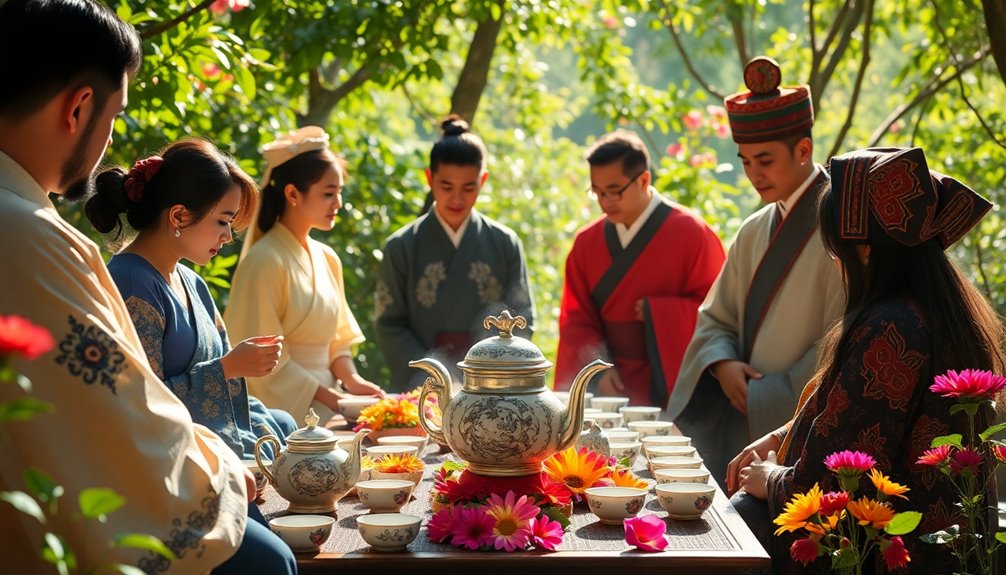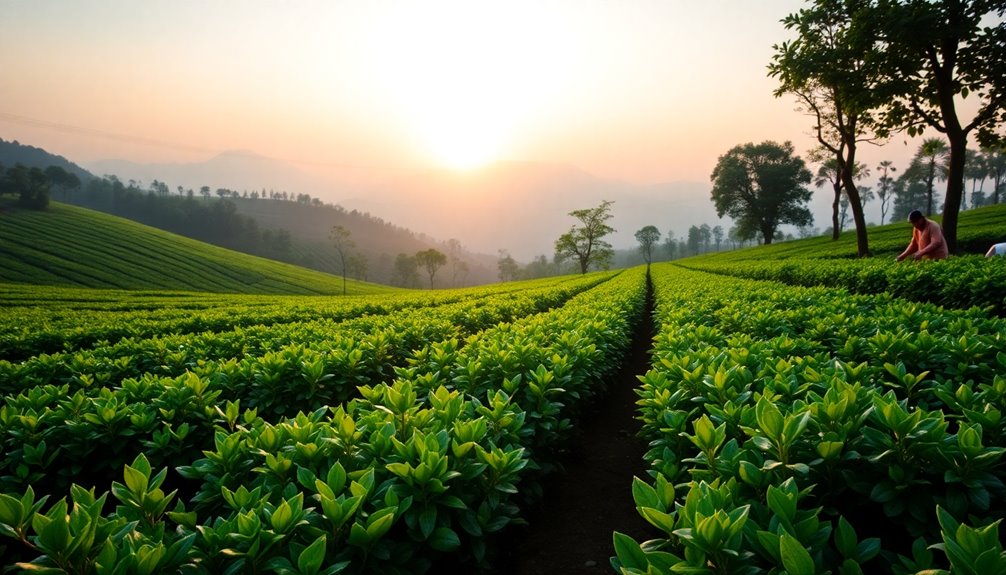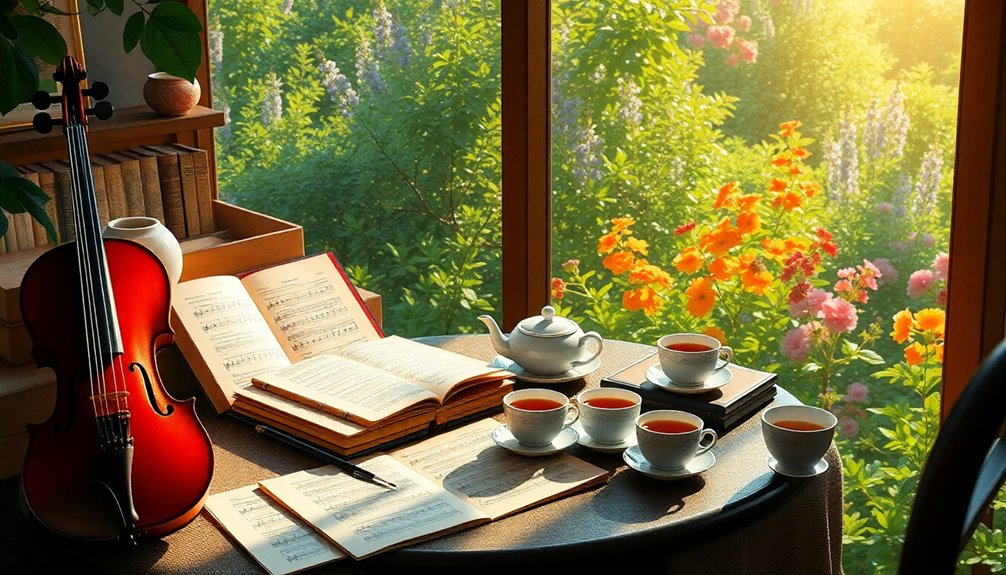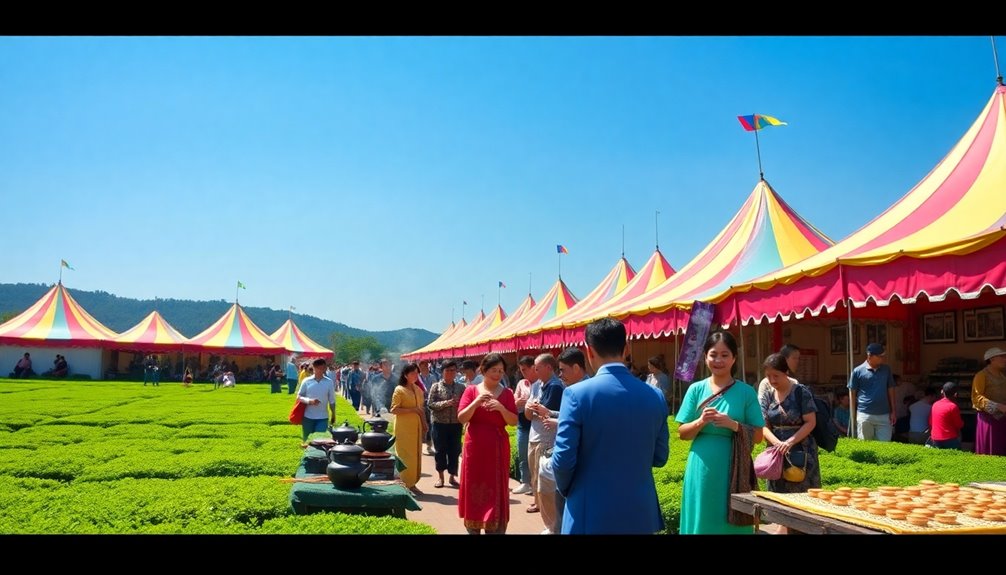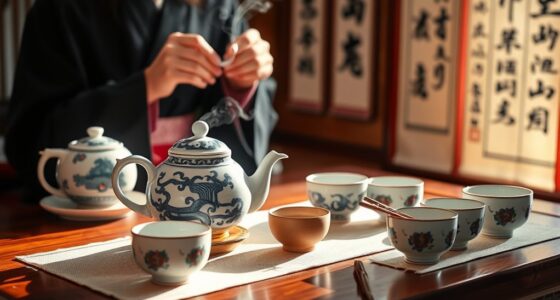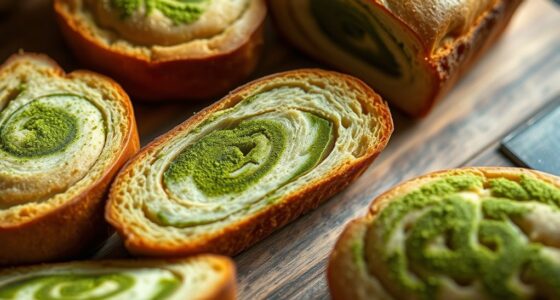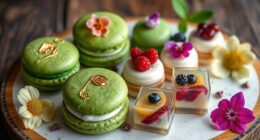Tea is central to rituals in many cultures because it symbolizes connection, warmth, and tradition. In Japan, the tea ceremony teaches mindfulness and respect. In India, serving chai welcomes guests and strengthens friendships. Afternoon tea in Britain creates special moments among friends, while sharing Maté in Latin America builds community bonds. Additionally, tea often acts as a peace offering, helping resolve conflicts and promote goodwill. Whether it's Moroccan mint tea or Tibetan butter tea, these rituals bring people closer together. Intrigued? You're about to discover even more exciting details about tea's role in our lives!
Key Takeaways
- Tea rituals foster mindfulness and respect, as seen in the Japanese Tea Ceremony, enhancing the experience of the beverage.
- In many cultures, serving tea symbolizes hospitality and warmth, strengthening social connections and community ties.
- Tea acts as a peace offering, promoting goodwill and encouraging open dialogue in various cultural contexts.
- Rituals surrounding tea transform simple acts into meaningful ceremonies, emphasizing shared values and communal bonding.
- Cultural significance and authenticity of tea practices are at risk due to commercialization, highlighting the need to preserve traditions.
Introduction
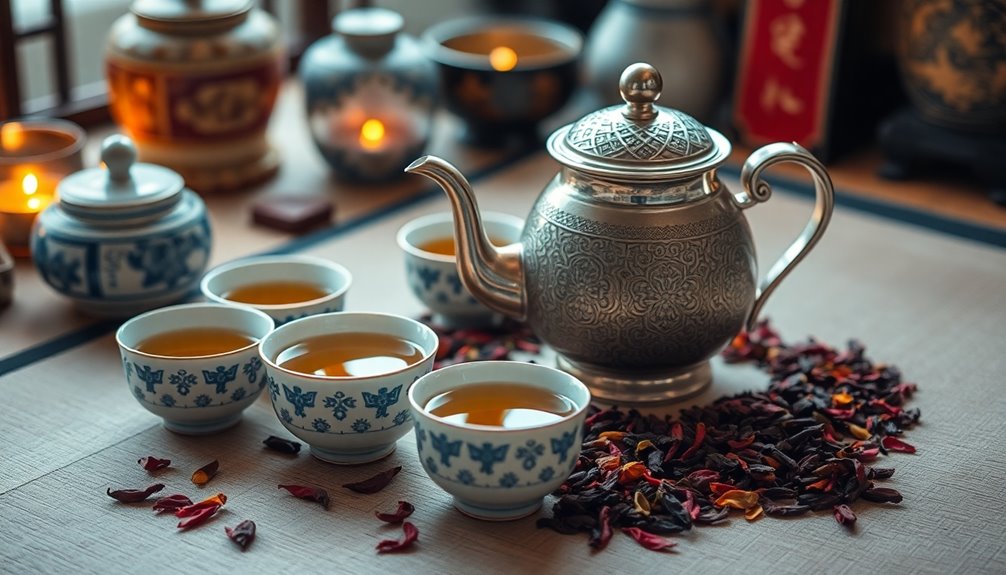
Tea has played a pivotal role in cultural rituals across the globe, intertwining history with social customs. For centuries, people have embraced tea not just as a drink but as a way to connect.
In Japan, the Japanese Tea Ceremony, or Chado, highlights mindfulness and respect, where you savor matcha with deep appreciation. You can feel the spiritual connection as you partake in this beautiful ritual.
In India, chai isn't just about drinking; it symbolizes hospitality. Offering tea to guests shows warmth and friendship, making everyone feel welcome.
Meanwhile, in Britain, afternoon tea started as a social event where friends gather to enjoy delicious treats and engage in lively conversation.
Across different cultures, tea customs foster community and social interaction. From sharing Maté in Latin America to serving kahwa in the Indian subcontinent, each practice highlights tea's role in building bonds.
Whether you're sipping a medicinal drink for wellness or enjoying a festive gathering, tea embodies the spirit of connection.
Global Tea Consumption Patterns

Across the globe, tea consumption reflects deep-rooted traditions and evolving preferences. With over 6 billion kilograms of tea consumed annually, it's one of the most popular drinks after water. China stands out as the world's largest tea producer, making about 40% of global tea. Meanwhile, India follows, contributing 25%.
In the United Kingdom, tea culture thrives, with the average person enjoying about 165 million cups daily! This shows just how important drinking tea is in British life.
On the other hand, in the United States, iced tea has grown rapidly in popularity, with over 40 billion cups consumed yearly. This shift showcases changing tastes.
In Japan, green tea reigns supreme, making up over 80% of their tea consumption. This preference highlights both traditional Japanese customs and the health benefits linked to green tea, like its unique flavor and antioxidants.
Tea houses in various cultures serve as social hubs, bringing people together to enjoy this cherished beverage.
Whether it's a hot cup in England or a refreshing iced tea in the U.S., global tea consumption reveals fascinating patterns shaped by history and modern influences.
Cultural Significance of Tea Rituals
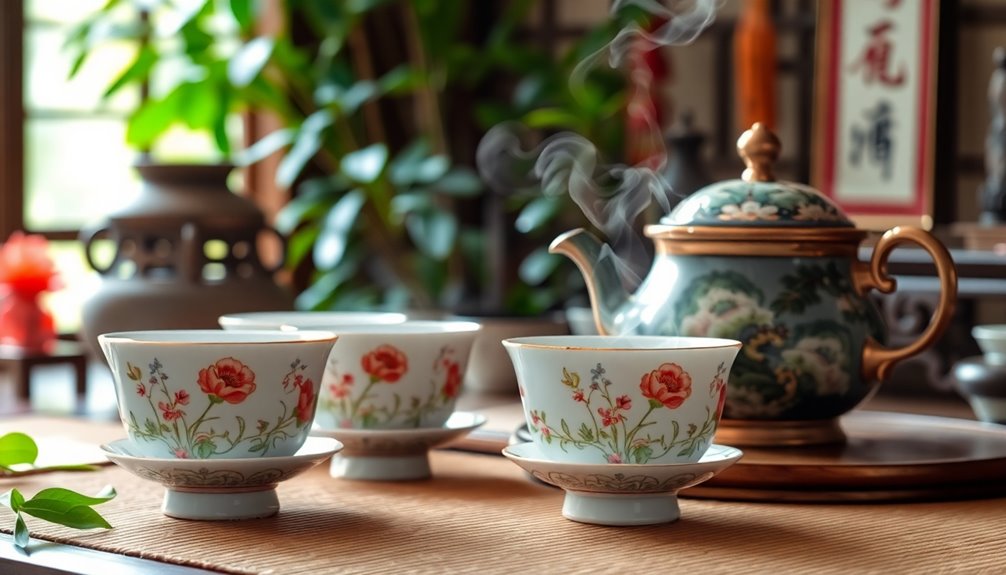
Rituals surrounding tea play a crucial role in fostering social bonds and cultural identity across various societies. When you think of tea, you might imagine more than just a drink; it symbolizes hospitality and connection.
For example, in India, serving Chai to guests isn't just about refreshment—it's a way to build friendships and strengthen community ties.
In Japan, tea ceremonies emphasize mindfulness and respect, turning a simple act into a beautiful ritual. Similarly, in Morocco, mint tea is served to symbolize warmth and welcome, making guests feel cherished. Each of these tea rituals has deep cultural significance, highlighting the importance of social interactions.
In the British tradition of afternoon tea, friends gather to enjoy not just tea, but the joy of each other's company, transforming everyday life into special moments.
Tibetan tea ceremonies, featuring butter tea, also underscore the communal aspect of sharing and respect among friends.
Tea as a Peace Offering
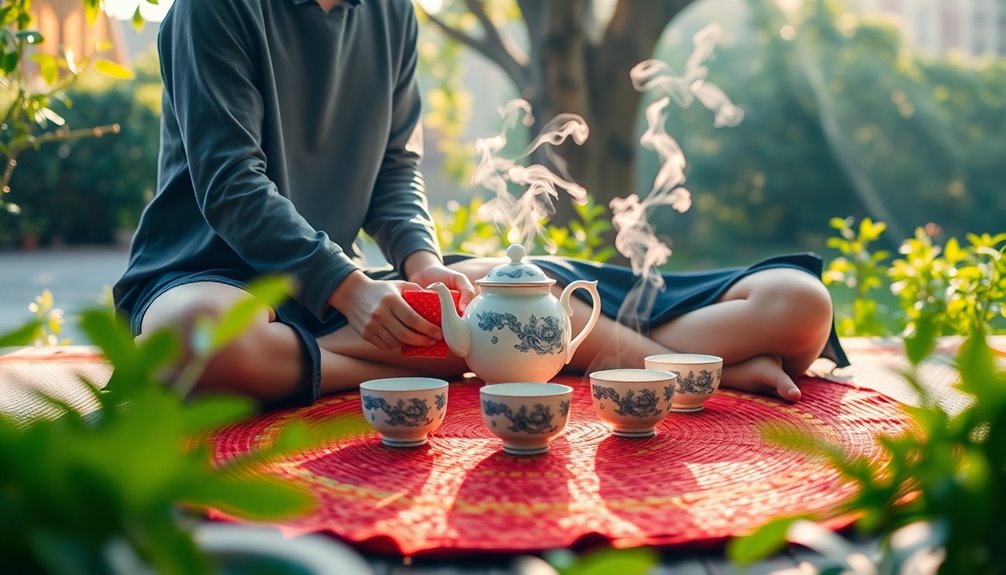
When you extend an offer of tea, you're not just inviting someone to enjoy a beverage; you're also fostering goodwill and connection. In many cultures, serving tea is a traditional gesture of hospitality.
When you invite guests to share a cup, you're showing respect and warmth. For example, in the Middle East, mint tea is often offered to ease tensions and promote friendly conversations.
In India, serving Chai, made with spices, helps build connections and resolve conflicts among family and friends. This act reinforces social ties and strengthens relationships.
Similarly, in Tibetan culture, offering butter tea symbolizes friendship, highlighting the importance of communal bonds and hospitality.
The practice of sharing tea, like the South American tradition of Maté, serves as a peace offering, encouraging open dialogue. This reinforces a commitment to community and understanding.
Cultural Appropriation of Tea Practices
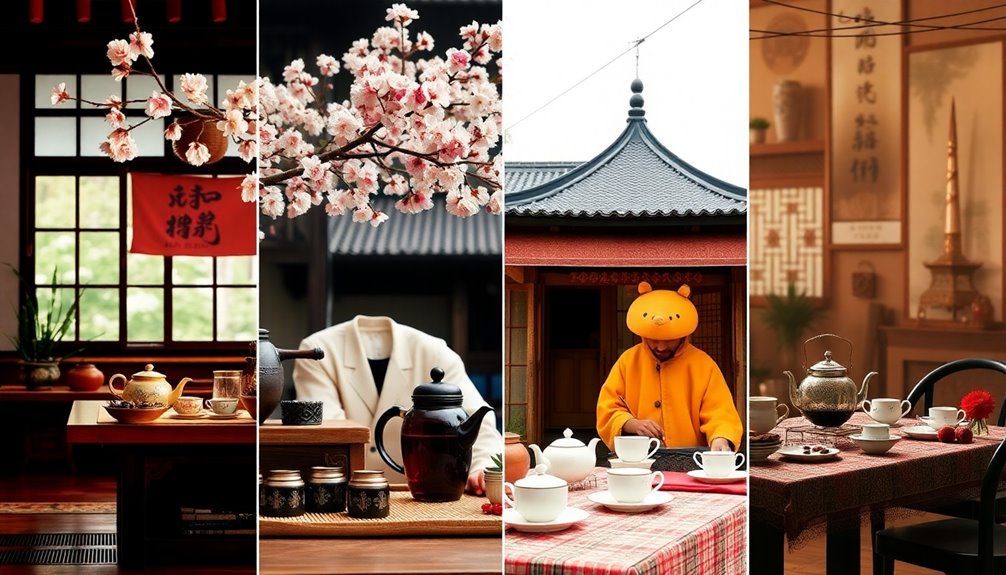
Cultural appropriation of tea practices has become a pressing issue as traditional ceremonies face commercialization and dilution. When you enjoy tea, it's important to remember the deep history behind it. For instance, tea ceremonies like the Japanese Chado are rich in mindfulness and meaning, but when these rituals are adapted without understanding, their authenticity is lost.
In Western countries, drinks like matcha and bubble tea are trendy, yet they can sometimes overlook the local customs and cultural heritage that define them. Cafes offering "Asian-inspired" tea drinks often prioritize profit over respect for these traditional practices. This commercialization can lead to the commodification of sacred rituals, transforming them into simple, trendy items rather than honoring their essence.
When you sip your tea, consider its journey. Recognizing the importance of cultural context helps preserve the beauty of these practices.
It's essential to celebrate and respect the original rituals, ensuring that we don't erase local customs or histories in our quest for enjoyment. By doing so, you contribute to a greater understanding of tea's role in various cultures, keeping the spirit of tea alive and vibrant.
Practical Applications
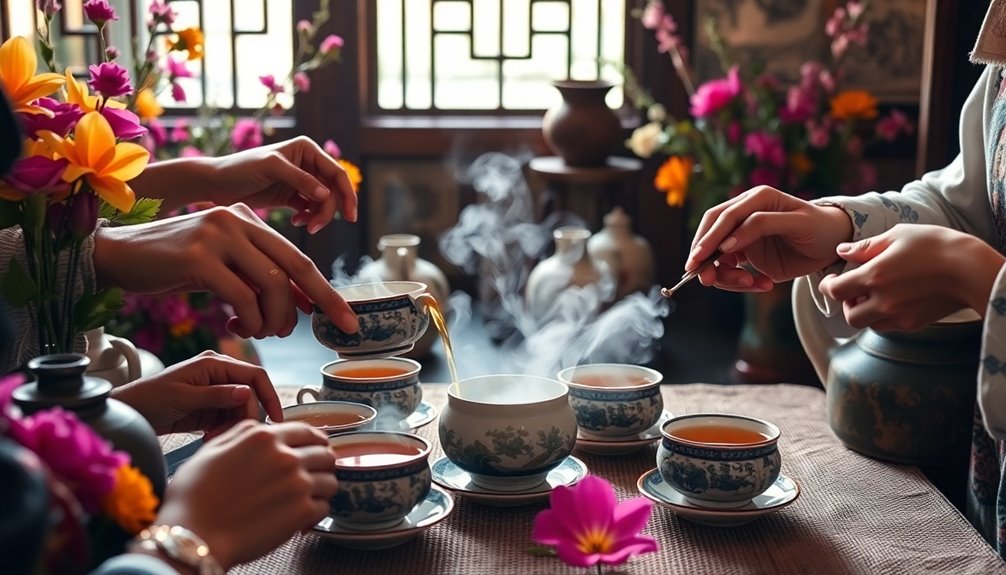
Connection through tea transcends borders, bringing people together in meaningful ways. You can explore the practical applications of tea in your life by embracing its communal aspects.
Start by hosting a tea drinking gathering with friends or family. Choose a variety of teas, like black tea or green tea, and share the art of tea preparation. This creates a delightful experience where everyone can participate in preparing and drinking.
Visit local tea shops to discover unique blends and learn about tea cultures from around the world. You might even find inspiration in traditions like the Japanese Tea Ceremony or India's Chai, where hospitality shines through every cup served.
Incorporate tea into your meals. For example, serve Thai iced tea alongside spicy dishes to enhance flavors and create a memorable dining experience. Additionally, learning about the health effects of tea consumption can help you choose the right teas for your gatherings and meals.
Frequently Asked Questions
Why Is Tea a Ritual?
Tea's a ritual because it encourages mindfulness and connection. You savor each sip, appreciate the preparation, and engage in shared moments with others, transforming an ordinary drink into a meaningful social experience steeped in tradition.
What Is the Cultural Importance of Tea?
Tea's cultural importance lies in its ability to foster connections and traditions. You see it in shared moments, mindful practices, and unique rituals that reflect values, hospitality, and community, enriching your experiences across diverse cultures.
What Is the Cultural Significance of the Tea Ceremony?
The tea ceremony's cultural significance lies in its ability to foster mindfulness, connection, and community. You engage in meticulous preparation, appreciating the tea's qualities, while embracing the shared experience that deepens relationships and cultural appreciation.
Why Do Arabs and Many Cultures Around the World Drink Tea?
You drink tea because it fosters connection and hospitality. In many cultures, it's not just about the beverage; it's a ritual that brings people together, enhances conversations, and strengthens community bonds through shared experiences.
Conclusion
In conclusion, tea brings people together in many cultures, creating special moments and lasting memories. Whether you're enjoying a cup with friends or sharing it as a peace offering, these rituals celebrate connection and harmony. Remember, by appreciating and respecting different tea practices, you can enrich your own experiences. So, next time you brew a cup, think about its journey and the traditions behind it. Embrace the joy of tea, and let it warm your heart!

